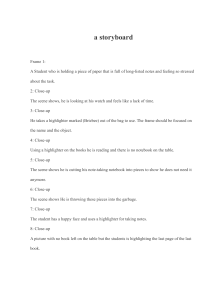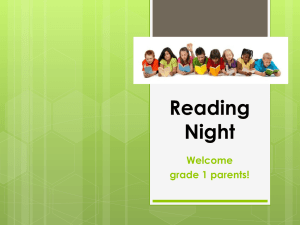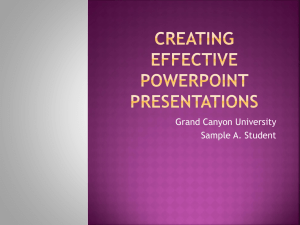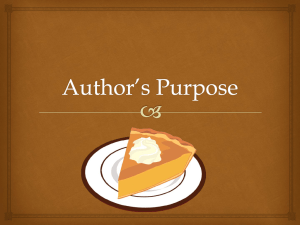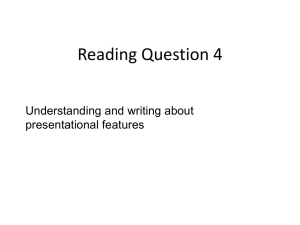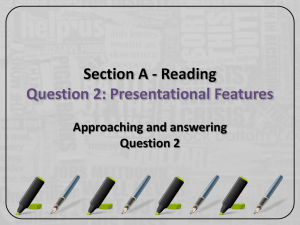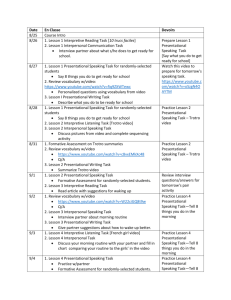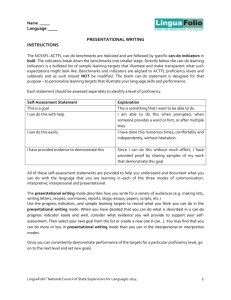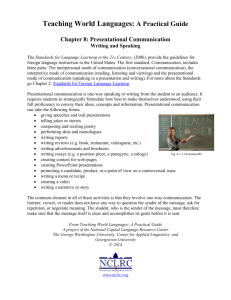AO2v – Explaining the Writer`s Use of Language
advertisement
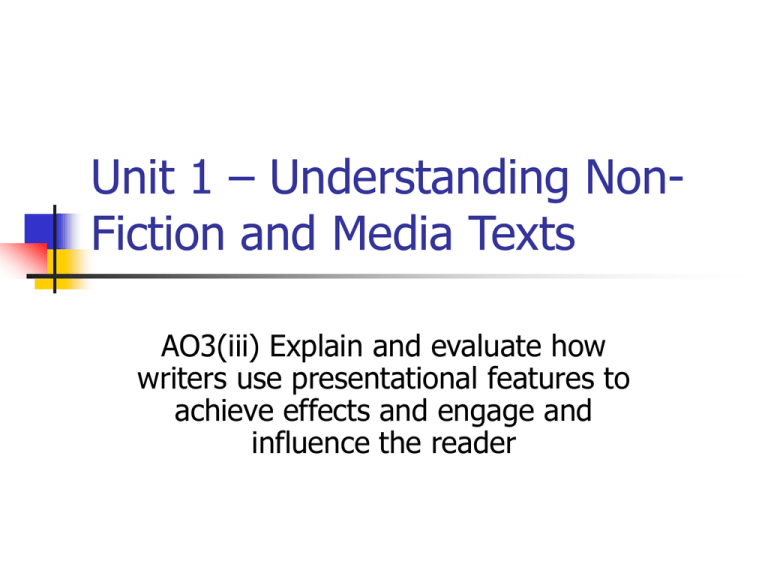
Unit 1 – Understanding NonFiction and Media Texts AO3(iii) Explain and evaluate how writers use presentational features to achieve effects and engage and influence the reader Assessment Objective AO3(iii) Explain and evaluate how writers use presentational features to achieve effects and engage and influence the reader Know some presentation terms Be able to explain the effects of these Evaluate HOW and WHY they are used Presentational Devices You need to learn some examples of presentational devices In the exam, you must be able to recall these You need to be able to identify these and give precise explanations of how a writer has used them Layout features Headings / sub-headings Boxes / Puffs Bullet points Balance of words and pictures Busy vs simple Length of paragraphs Logos and slogans Images Photos / Pictures Illustrations Charts / Diagrams Close-up Medium-shot Long-shot High or low angle Point of view Print Styles Type of font Size of font Bold, italic, underlined Colour of font Capitals vs lower case letters Use of colour Think of the different connotations that colours have e.g. black = death, green = environment, yellow = happiness Consider combinations of different colours Black and white / Monochrome Large heading emphasises the message Simple, green lettering connotes simple, healthy choices Large close-up makes it more appealing Green background colour reinforces healthiness Lots of close-up photos to emphasise how tasty the food is Lower case letters suggest it is informal and fun White font makes the text leap out at the reader Use of text boxes to suggest the layout of a menu Reading Framework 1. 2. 3. 4. 5. Read the questions Read the text Work out the PAFT and message Label examples – check the question Plan your response – use a PEE table PURPOSE: what job is the writer trying to do? Argue Persuade Advise Inform Explain Describe Analyse Review Comment Imagine Explore Entertain AUDIENCE: the reader Children Teenagers Parents Pensioners Workers Experts Fans Men Women Adults PAFT Age Interests Lifestyle Gender Education Class Job Hobbies Politics Purpose Audience Form Tone FORM: type of writing Leaflet Web page Letter Speech Report Article Story Email Essay Advert TONE: what is the mood of the writing? How are we addressed? Enthusiastic Passionate Hopeful Optimistic Humorous Angry Frustrated Pessimistic Sad Annoyed Questioning Doubtful Suspicious Sarcastic Ironic Objective Subjective Neutral Cynical Knowledgeable Model Question How does the presentation add to the effectiveness of the whole text? [8 marks] Plan your answer – 1 Highlight the text, identifying the most important examples of presentation you can find 8 marks = 16 minutes 8 marks = at least 1 really good example for each bullet point Annotate your examples with explanations of the precise effect Plan your answer – 2 Pictures Print styles Layout Point Evidence Explain (Identify a technique) (Detailed description) (Give the precise effect) Explaining effects You must give explanations that are matched to the text you have read Do not make generic statements like “it is eye-catching” Every explanation must use the word “because” Banned answers YOU MUST NEVER USE THE FOLLOWING PHRASES!!! The picture is eye-catching It is bright and colourful It looks interesting The writing stands out … UNLESS YOU EXPLAIN WHY Useful analytical language This This This This This connotes… means… suggests… represents… symbolises… This This This This This highlights… shows… makes us feel… creates… implies… Use this vocabulary to support your analytical and evaluative comments about pictures Using PEEL Point – Identify a technique Evidence – Give a short description Explain – The effect of this technique on the reader Link – Refer back to the question (repeat some of the words) Using PEEL – an example How are presentational features used to influence the reader? The writer has used several close-up photographs of the food on offer. For example, the main image is of one of the salads. It is a close-up shot taken from a high angle. The effect of this is to make us think that the food looks really tasty. A close-up shot also makes the salad look a lot bigger than it might be. This is persuasive because we are more likely to choose this as a meal option. It helps to emphasise the fact that McDonald’s offers more than just burgers and fries and so is likely to interest the target audience i.e. women who want to eat more healthily. How this is assessed Band 1 Band 2 Some evidence of understanding Some appreciation of presentation Attempts to support with examples Band 3 Limited evidence of understanding No real appreciation of presentation Very few and poorly chosen examples Clear evidence of understanding Clear analysis of presentation Relevant and appropriate examples used to support ideas Band 4 Full and detailed understanding of the content Detailed and perceptive analysis of presentation Relevant quotations with perceptive comments



